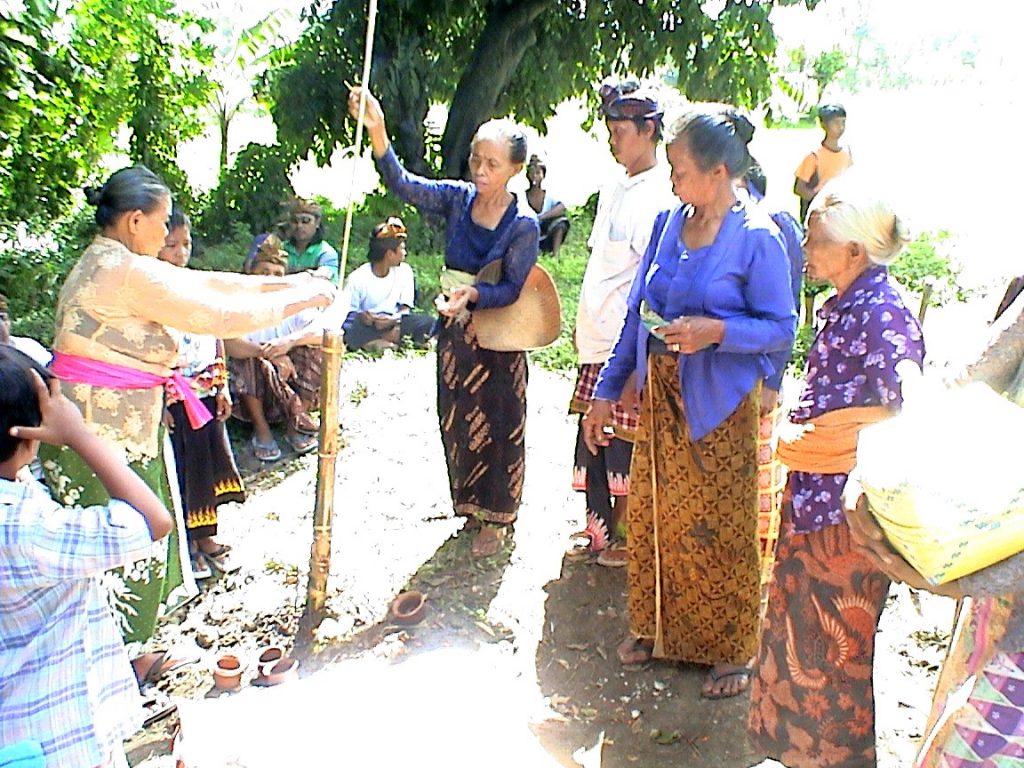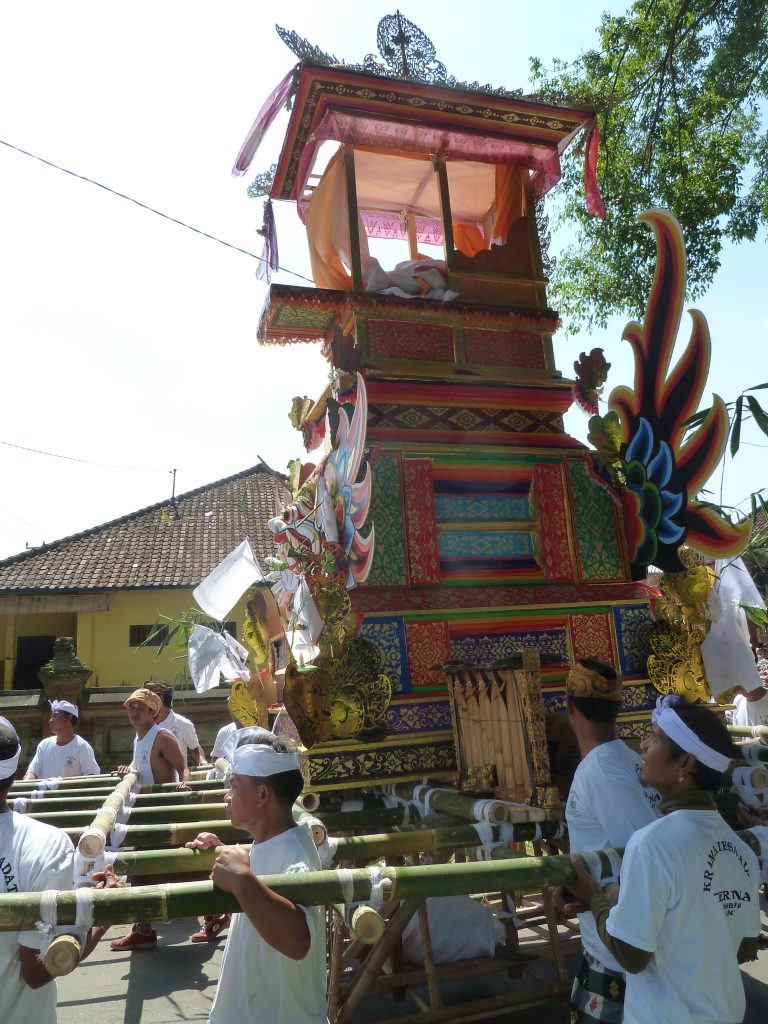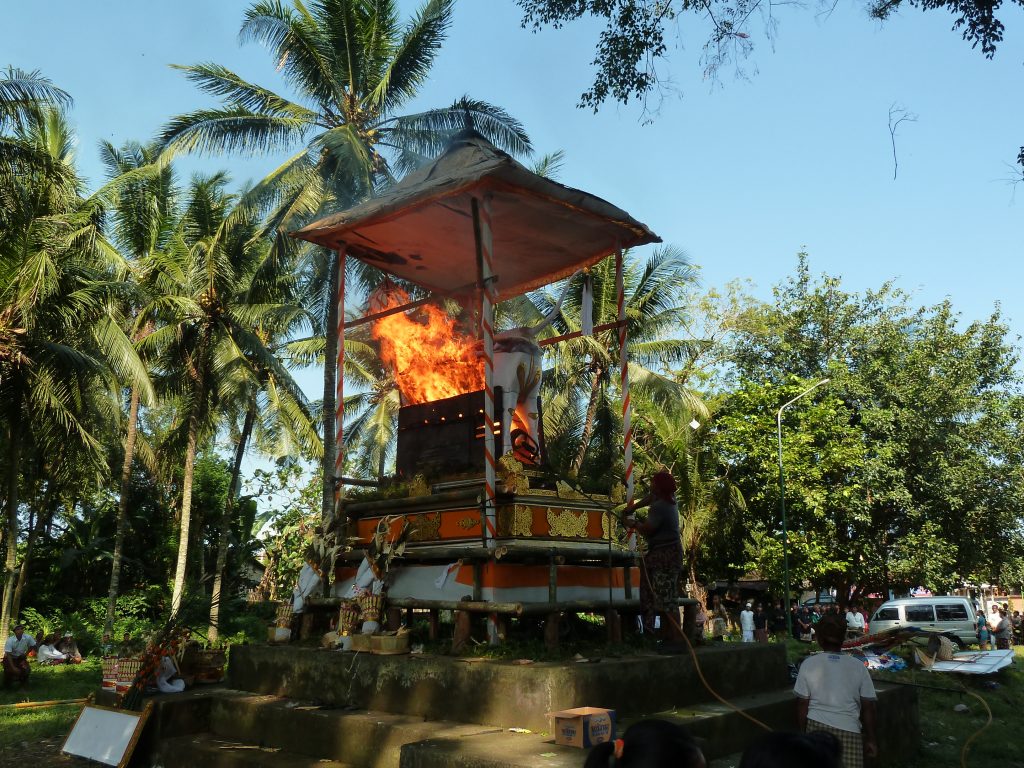While many parts of the world might deem the death rituals carried out by the Balinese to be strange or unorthodox, these rituals are deeply rooted in the beliefs of Hinduism and play a central role in completing what is known as samsara, or the cycling of rebirth (see Hooykaas 22). In Hindu tradition, it is believed that the spirit of a deceased person, known as preta, becomes trapped in the realm of the living, roaming freely to haunt people until it is freed from this realm and allowed to enter the spirit realm (Hooykaas 22). In order to release the soul from the realm of the living so it may transcend to the spirit realm, certain rituals must be completed. Pitra Yadnya, or the rituals for the ancestors, are a common practice in Balinese tradition in order to allow the soul to transcend this reality (Hooykaas 22). In Balinese tradition, it is believed that once the spirit is liberated from the body through an elaborate series of rites, the soul then becomes fused with the collective ancestors who are worshipped in the village temples (Warren 43). Not only do the death rituals practiced in Bali serve to free the spirit from the body and allow it to pass into the ascendant realm, but they are also crucial as they protect the family and community from the dangers associated with the passage between realms (Warren 43). In comparison to Western death traditions, Balinese death rituals are more of a celebration of the rebirth of life rather than mourning for the loss of life, as a result of the contrast in beliefs of the Balinese.
Pitra Yadnya, also known as ngaben, is comprised of many different elaborate rituals which contribute to the release of the soul from the living realm to the realm of the ancestors. Ngaben, referring to a cremation ritual, is considered to be the most critical death ritual in the Balinese tradition (Gupta 254). Before ngaben is performed, the corpse is washed, and the patulangun, a form of a cremation bier which typically depicts an animal, is prepared for the ceremony (Warren 44). Preparation for the ritual is often a community effort as the fellow people of the village often help to construct the bier and make a large number of ritual offerings required to prepare the spirit for its journey to the soul realm (Stephen 441). It is not uncommon for the body of the deceased to be buried for some time while the bier is prepared, and the family makes ritual offerings (Warren 44). Historically, burial before the cremation has been looked upon negatively as it has been associated with the lower classes as it is typically the result of not having the funds or resources to perform a quick ngaben; however, prior burial has become more positively accepted in Bali (Warren 44). This positive perspective on burial prior to ngaben could be the result of the belief that the deceased should be allowed to rest with the earth mother-goddess before the cremation; however, the body should not be left for more than a year (Warren 44). Once the family has accumulated the wealth and resources for the ritual, the ngaben can then begin.

The family will then consult a brahmin, or Hindu priest, in order to select an auspicious day for the ngaben to occur on (Williams 2016). It is especially important to select an auspicious day for the ritual in order to help guide the spirit to the best rebirth possible (Stephen 427). Once the day of the ngaben has arrived, the family will go to the gravesite and perform a ritual known as ngawagen, meaning the awakening, in order to recall the spirit of the deceased person to inherit a symbolic body, known as the pangawak (Stephen 440). After the spirit has been recalled into the symbolic vessel, it is carried home where it is welcomed as though the deceased person has returned from a long absence, which is known as penyapa, meaning ‘greeting’ (Stephen 440). Relatives of the deceased then come to the house to make offerings of food and drink to the deceased (Stephen 440). In cases where the body is not buried prior to cremation, such as the body of a brahmin or the body of someone from a wealthy family, the ritual of ngawagen is omitted (Stephen 440). Instead, the ritual begins with recalling the soul from the pura dalem, meaning the village temple associated with the spirits of the dead, to re-inhabit the body for the ritual (Stephen 440). From this point forth, the only difference between the ritual procession for an immediate cremation and one for a person who had been buried already is the presence of a physical body in the immediate cremation instead of the use of a symbolic body.
After the spirit has been recalled, the bier and tower in which the corpse is to be carried to the cemetery are placed on the main road in front of the house (Stephen 442). The body is then washed with holy water and decorated with jewelry and flowers before being wrapped in white cloth by male relatives and placed in a plain wooden box (Stephen 442). The box containing the body is then placed in the bier with other rituals objects which symbolize the different aspects of the spiritual, mental, emotional, and physical aspects of the deceased (Stephen 443). A ritual known as ngaskara is then performed in order to reunite the body and the spirit of the deceased individual, which is believed to bring the person back to life for a brief period (Stephen 443). This is symbolized by the pedanda, or priest, lighting a lamp at the conclusion of the ngaskara ritual to show that the deceased has come to life again (Stephen 443). During this ritual, the gamelan orchestra provides musical entertainment for those present (Bakan 1999:9). Once the lamp is lit, the family will wait in anticipation for the lamp to go out, symbolizing that the soul has departed on its journey to the spirit realm (Stephen 443). Once the spirit has begun its journey to the spirit realm, it is time for the body to begin its journey to the cemetery.

The procession to the cemetery is known as pengutangan, in which multiple strong men carry the tower and animal sarcophagus through the town to the cemetery for cremation (Stephen 443). This event is known to be quite public and particularly energetic (Stephen 443). The gamelan orchestra is once again providing entertainment, this time playing rousing music to keep the mood of the ceremony upbeat (Bakan 1999:11). Throughout the procession to the cemetery, the men carrying the tower are frequently spinning the sarcophagus, which is suspected of confusing the evil residents of the lower realm so that they may not drag the soul of the deceased down with them (Stephen 444). In order to prevent the body from falling out of the casket, a family member typically rides atop of the tower as well (Stephen 444). Once the corpse arrives at the cemetery, the coverings are cut open to reveal the face, and the body is washed with copious amounts of holy water (Stephen 444). The body is then wrapped in many layers of fresh cloth, and the symbols of the deceased physical, spiritual, mental, and emotional aspects are placed in the casket with the body, and the funeral pyre is lit beneath the sarcophagus (Stephen 444). While the corpse burns, the gamelan orchestra plays the beleganjur, which is a Balinese battle song believed to ward off evil spirits and help guide the soul to the spirit realm (See Bakan 2011 for more) (Bakan 1999:71). While the cremation has now taken place, this does not mark the conclusion of ngaben.

Once the fire has burned down, the ashes are collected, and any remaining bones or pieces of symbolic items are ground up into a fine paste (Stephen 445). More offerings of food are then made to the departed before the ashes are carried to the ocean for the ritual of nganyut, meaning to cast away into water (Stephen 445). The ashes of the deceased are then cast into the ocean so that they may become one with the elements once again (Stephen 445). Once the family returns to the village, two final rituals are completed to close ngaben. The first is known as mapegat, which is a ceremony where the family severs their ties to the deceased (Stephen 445). The second is called caru, which is a ritual in which the area used for ngaben is cleansed in order to eliminate any negative forces (Stephen 445). At the conclusion of ngaben, the family will continue to make ritual sacrifices in order to regain their ritual purity as death within the family is considered to be ritually polluting (Hooykaas 22).
After having analyzed the Balinese death rituals, it can be seen that there are some differences present between Balinese rituals and orthodox Hindu traditions. One difference between Hindu death practices and Balinese death practices is that if the cremation cannot be performed within two days of death in Hindu traditions, the body may be placed on ice (Gupta 254). In contrast, it is common practice to bury the body for some time in Balinese traditions (Warren 44). Another difference between the Hindu traditions and Balinese is that in Hindu traditions the family is not supposed to severe ties with the deceased until one year has passed, as it is believed that after one year the soul has moved on into another form (Gupta 256). In contrast, the Balinese severe ties at the closing of ngaben in the ritual known as mapegat (Stephen 445). While some differences may be present between the Balinese and Hindu death rituals, both have a powerful influence on Hindu traditions and culture.
In Hindu cultures, the colour white is closely associated with death (Gupta 256). As a result, it is common practice to wrap the body in white cloth, and newly widowed women are expected to wear white clothing during the period of mourning (Gupta 258). Widowed women are also expected to wear a white sari, no makeup, and no jewelry for the remainder of their life to symbolize their mourning (Gupta 258). This understanding can also explain why it is considered to be inappropriate to present a newly wedded couple with an article of white clothing as a gift, as this is seen as an inauspicious action (Gupta 256). In Hindu culture, regular offerings are also made to the deceased person to soothe the soul, which is especially important if the cremation ritual cannot be performed immediately (Warren 43). These offerings to the soul, as well as the gifts presented to the mourning family by other members of the community, highlight the high level of interdependence present in Hindu culture and the secure connections between the living and the dead (Warren 46). Death rituals in Hindu tradition also serve as a way of remembering the deceased, as tradition mandates that any negative feelings towards the person will be disregarded after their passing as the deceased is to be valued no matter what (Gupta 256). In summary, the death rituals practiced in both Balinese tradition and other Hindu traditions are an essential part of the completion of samsara, which is a central value in Hinduism as it shapes many of their beliefs and aspects of their culture (Stephen 427).
REFERENCES AND FURTHER RECOMMENDED READING
Bakan, Michael B. (1999) Music of Death and New Creation: Experiences in the World of Balinese Gamelan Beleganjur. Chicago: The University of Chicago Press.
Bakan, Michael B. (2011) “Preventive Care for the Dead: Music, Community, and the Protection of Souls in Balinese Cremation Ceremonies.” In The Oxford Handbook of Medical Ethnomusicology,Edited by Benjamin D. Koen. Oxford: Oxford University Press.
Gupta, Rashmi (2011) “Death Beliefs and Practices from an Asian Indian American Hindu Perspective.” Death Studies 35:244-266. Accessed February 1, 2020. doi:10.1080/07481187.2010.518420
Hooykaas, Christiaan (1973) Religion in Bali. Leiden: Brill.
Stephen, Michele (2010) “The yogic art of dying, Kundalinī yoga, and the Balinese ‘pitra yadnya’.” Bijdragen Tot De Taal-, Land- En Volkenkunde 166:426-474.
Warren Carol (1993) “Disrupted death ceremonies: popular culture and the ethnography of Bali.” Oceania 64:36-56. Accessed February 1, 2020. doi:10.1002/j.1834-4461.1993.tb02446.x
Related Topics for Further Investigation
Samsara
Gamelan orchestra
Pancha Mahabhutas
Preta
Pitr
Pitr-loka
Beleganjur
Patulangun
Dewi Pertiwi
Lembu
Wadah
Pitra Yadnya
Pengutangan
Ngaskara
Pura dalem
Ngawagen
Pangawak
Penyapa
Nganyut
Mapegat
Caru
Hindu wedding rituals
Noteworthy Websites Related to the Topic
https://en.wikipedia.org/wiki/Ngaben
http://factsanddetails.com/indonesia/Minorities_and_Regions/sub6_3h/entry-4025.html
https://www.frazerconsultants.com/2017/05/cultural-spotlight-balinese-funeral-traditions/
https://www.funeralguide.co.uk/blog/death-around-the-world-bali
Article written by: Kieran Meadows (Spring 2020) who is solely responsible for its content.
